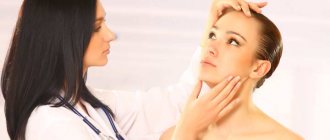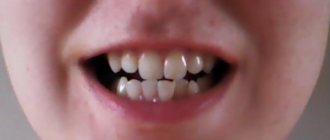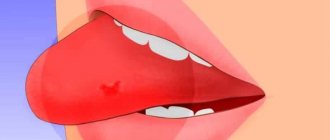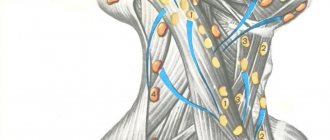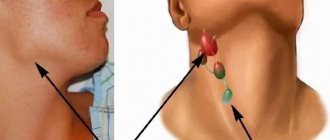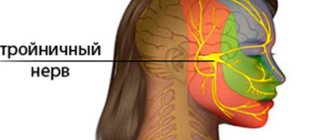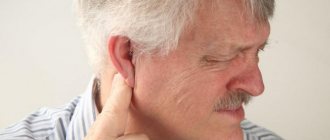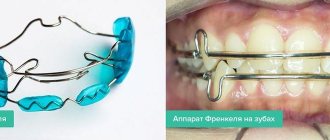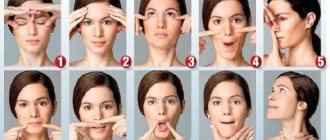Hello, dear friends. One of the scariest moments in my life was when my mother had a stroke. Fortunately, we were able to quickly provide assistance, so the consequences were not catastrophic. Mom recovered quite quickly. And only one consequence after a stroke caused inconvenience for a long time - facial asymmetry.
But over time we managed. And gymnastics provided the main help in this. It turns out that it helps in many cases. And this article is about how to get rid of facial asymmetry yourself at home.
What is considered pathological asymmetry?
A slight discrepancy between the right and left halves of the face is present in everyone. The differences are so insignificant that you can only notice them if you look closely. The right eye may be slightly wider than the left, one ear is slightly higher than the other. Have you noticed it yourself?
If the difference is less than 2 mm (or 3 degrees), then this is not a pathology and does not require correction. This is how our face scores points in the personality column.
There is an interesting test to determine how different the left and right halves of our appearance are. I experimented on myself: the result is amazing.
You need to take a photo looking directly into the lens under conditions of uniform lighting. We upload the photo into a graphics editor. Use a vertical line to divide the face in half, making two images.
And in each we make a mirror image for the half, thus obtaining a whole oval of the face. I didn't recognize myself. But it never occurred to me before that I had slight asymmetry. I agree with the easy one.
I won’t show my results, but look at the photo of Canadian actor Ryan Reynolds. Isn't it like it's like three different people? But handsome Brad Pitt (pictured above) is almost symmetrical.
But, alas, sometimes the facial features on the left and right are too different. And they become the reason for dislike of appearance. This means there is a need to work on yourself. Fortunately, you can almost always find a way out.
Facial asymmetry: causes, norm and pathology
Many patients decide to see a plastic surgeon because they notice that their face or body is slightly asymmetrical. I have to explain to many of them that in nature there are no completely symmetrical faces and bodies: minor asymmetry is present in the structure of the face and body of any person, and a plastic surgeon will not expose you to the risks of surgery unless there are more serious reasons for this than minor asymmetry . However, there are cases in which asymmetry is very pronounced and actually ruins a person’s life. Today I would like to tell you in more detail within what limits asymmetry is acceptable and aesthetically neutral, and in what cases correction of facial asymmetry is required.
Let's start with the fact that the dominance of one “half” of the human body over the other is a completely normal and natural phenomenon , since each of us has a “leading” hand (some have the right, some have the left), “leading” “leg – it is usually not significant, but still larger than the other in size. As for the face, a slight difference in proportions is perceived by the human eye as harmony, but complete symmetry, on the contrary, is somewhat frightening: try taking your photograph from the front and placing a mirror exactly in the middle. This is what your face would look like if it were completely symmetrical.
A face with slight asymmetry and an example of complete “mirror” symmetry of the left and right halves of the face
It is completely within normal limits that one eye has a slightly different shape, that the tip of the nose “looks” a little to the right, and the right ear is located slightly higher than the left. The right side of the face of right-handers is slightly wider than the left, the facial features on the right are more “solid”, angular, more “masculine”. The left half of the face, on the contrary, is softer and more “feminine”. Moreover, both men and women. This is part of the reason why we like ourselves more from some angles than from others.
Natural asymmetry gives you charm and individual charm , which is difficult to capture and describe in words - it is read at the level of sensations. Plastic surgery for minor distortion (violation of proportions by less than 2-3 mm) is not indicated . Correction of facial asymmetry is required only if there is a pathological difference in proportions, which is conventionally equal to 2-3 mm in linear measurements and 3-5 degrees in angular measurements.
Significant facial asymmetry, photo
If we talk specifically about the asymmetry of facial features, it can be either congenital or acquired . The way to eliminate this problem also depends on what exactly is the cause of the asymmetry of features.
Thus, the causes of congenital asymmetry of facial features can be:
- Intrauterine trauma;
- Disorders associated with the formation of bone tissue;
- Pathologies of the formation of articular tissue and the joints themselves;
- Disturbances in the processes of formation of cartilage and articular tissues.
The causes of acquired facial asymmetry can be:
- Strabismus. This can cause distortions to form in the upper part of the face;
- Lack of teeth. If teeth are missing for a long time, this can lead to changes in the bite and deformation of the lower part of the face;
- Incorrectly healed fractures of the facial bones. The most common example is a crooked nose;
- Features of facial expressions. For example, you involuntarily squint only one eye or smile from only one corner of your mouth. In this case, your face may also become asymmetrical over time.
- Severe asymmetry of facial features can also be caused by damage to the facial nerve or partial immobility of the facial muscles. In this case, the main problem is not only and not so much asymmetry, but a violation of important functions: the eyelid does not work well, and the eye does not close or closes poorly; there are problems with facial expressions, eating, sleeping, speaking; the skin on the face sags a lot, facial wrinkles are smoothed out, one eye may become larger than the other... In this case, first of all, you should solve problems of a neurological nature and try to restore the functioning of the facial muscles, and only after that think about plastic surgery.
In cases where asymmetry causes psychological discomfort, but does not pose a threat to health, first of all you should think about how you can correct it with “improvised” means: hairstyle, makeup - in the case of women, or, for example, growing a mustache or beard - men. These techniques often help disguise pronounced asymmetry. In this case, the help of a plastic surgeon should be resorted to last.
Age asymmetry
In addition to skin aging and changes in facial contours, nature has given us another “gift”: it turns out that over the years, a person’s facial features become more asymmetrical. According to researchers, every 10 years of life is reflected on our face in the form of a displacement of facial structures by an average of 0.6 mm. These data were obtained by analyzing three-dimensional images of people at different periods of their lives, and this age-related asymmetry is most pronounced in the lower third of the face - in the mouth, chin, neck and cheeks.
If you still have questions, you can ask them in the “question-answer” section.
In order to accurately determine whether surgery is needed in your particular case, and whether surgery will help correct asymmetry, of course, you need a consultation with a plastic surgeon. Make an appointment for a consultation with plastic surgeon A.P. Panaetov. by phone (viber, whatsapp) or through the feedback form on the website:
What facial asymmetry can gymnastics overcome?
Let's look at the reasons for this phenomenon. Traditionally they are divided into 2 parts.
1. Congenital
If the jaw bones, skull, facial joints, connective or muscle tissue develop incorrectly, this leads to distortion of facial features.
If the distortion is small, hairstyle and makeup for a woman, beard and mustache for a man will help make it invisible.
In other cases, correction in the form of surgery will most likely be required. Modern plastic surgery works wonders and can fix almost anything.
2. Purchased
Here, the source of asymmetry in an adult or child can be injury, improper “ownership” of one or another part of the face, or disease. Most often this is:
- the result of severe strabismus;
- inflammation of the facial nerve, which can occur from walking without a hat in winter, from a draft in summer, or even from stress;
- clamping of a nerve fiber, for example, due to a stroke - and it must be said that today it can occur not only in an old person, but even in a teenager;
- dental problems, when the entire row of teeth in the jaw is missing, or an incorrect bite has developed;
- fractures of the jaw and other facial bones, their improper fusion;
- torticollis in children;
- incorrect habits and facial expressions, when a person chews exclusively on one side or always sleeps in the same position, or regularly squints with one eye.
What is the danger of facial asymmetry due to malocclusion?
- excessive tension in the temporomandibular joint: this problem provokes headaches, joint dislocations, tension in the neck muscles, curvature of the spine, “clicking” of the jaw, the appearance of bruxism - involuntary grinding of teeth during sleep,
- teeth wear unevenly , which not only aggravates facial asymmetry and complicates chewing food, but also leads to dental problems (the formation of caries and its complications, the appearance of plaque and tartar on the teeth, frequent inflammation of the gums),
- psychological problems: decreased self-esteem
How to correct facial asymmetry
What to do if a stroke or nerve inflammation has caused part of the face to lose sensation and a clearly visible curvature?
First of all, we go to the doctors to accurately determine the cause and agree on treatment.
You should consult with the following specialists:
- dentist;
- orthodontist;
- ophthalmologist;
- maxillofacial surgeon;
- neuropathologist.
If surgical correction of the pathology is not prescribed, massage and special facial exercises will most likely be indicated, which I want to tell you about in as much detail as possible in this article.
Too "individual" face
Sometimes facial asymmetry goes beyond slight disproportion of features.
A significant “discrepancy” between the halves can be due to a number of reasons, including:
- congenital factors - intrauterine anomalies in the development of the bone, muscle and nervous systems;
- acquired external and internal factors - facial injuries, inflammation of the nerves, malocclusion or missing teeth, paralysis of the facial muscles as a result of a stroke, bad habits (sleeping on one side, chewing gum), age.
It is quite easy to distinguish physiological asymmetry from pathological one. Normal asymmetry is not obvious, and the difference is noted only when closely comparing the halves.
In pathology, differences in symmetry are pronounced: the difference in the size of parts of the face exceeds 3 mm or 5 degrees and is visible even at a quick glance.
In addition to external disproportion, a pathologically asymmetrical face may be characterized by weakness of facial muscles and distorted articulation.
With pronounced facial asymmetry, a person, as a creature tirelessly striving for harmony, wonders what to do about it.
There are two ways to solve the problem:
- hide facial asymmetry with makeup and hairstyles;
- undergo conservative or surgical treatment.
Optical illusions: how to hide facial asymmetry
If the individuality of the face goes beyond harmony, but does not reach a medical problem, you can correct facial features with makeup.
To correct asymmetry, the same products are used as when sculpting the face - a set of dry and cream corrective products in dark, natural and light shades.
Correctors are applied according to the following algorithm:
- parts that need to be hidden or reduced are darkened;
- areas that require volume and enlargement are highlighted;
- the boundaries between zones are carefully shaded with a brush.
Gymnastics against facial asymmetry
Exercises are general strengthening exercises that have a beneficial effect on the skin and muscles, promote rejuvenation, and fight wrinkles and a double chin. But there is also special facial gymnastics against asymmetry.
In any case, you can make them at home. The first gymnastics is like exercise, 1-2 times a day. The second - depending on the condition. In principle, the more often the better, targeting problem areas.
A set of general strengthening exercises
- Palms on the forehead, raise and lower the eyebrows, as if we were very surprised, 10 times.
- We tense our eyelids, opening our eyes as wide as possible for 3 seconds, then relax. Repeat 10 times.
- We inflate our cheeks, and then exhale sharply, making them hollow, 10 times.
- We alternately inflate one or the other cheek 10 times.
- We stretch our lips into a very wide smile, exposing our teeth. Then we collect it into a tube. Repeat 10 times.
- Move the jaw forward 10 times.
- Move your jaw left and right 10 times.
- Open and close your mouth 10 times.
- We close the upper lip with the lower lip, pulling the lower one up as much as possible. We feel the tension of the skin under the chin. Repeat 10 times.
- Move your chin forward and tense your neck muscles. Repeat 10 times.
A set of exercises against asymmetry
- For the affected side, repeat each exercise 20 times. For another - 10 times.
- We close our eyes tightly, then relax.
- Putting your fingers on your eyebrows at your temple, make an “up and down” motion with your eyes.
- We frown - slowly, with serious effort.
- We stretch the eyebrows up to the limit, at the same time raising the eyelids.
- Place your fingers on the wings of your nose and draw in air through resistance.
- Having closed our lips, we stretch them into a thin thread, pronouncing “I”.
- We alternately smile with the left and then the right half of our lips.
- We roll our tongue into a tube, open our mouth slightly, inhale and exhale.
- We move our tongue in an inner circle, moving between the muscles of the cheeks and teeth.
Acquired asymmetry can be corrected without surgery. But if these are consequences of the disease and after six months they do not disappear, then you should consult a doctor and consult about the condition of the muscle. The problem may need to be addressed surgically. But often gymnastics is enough.
Now let's digress a little.
Neuroscience's relationship to asymmetry
If we talk about the disease from the neurological point of view, facial asymmetry is primarily revealed by a lack of symmetry in the cerebral hemispheres. Each of the large hemispheres carries out microregulation of sensations (that is, sensory), as well as motor skills of the corresponding halves of the body, in different ways. At the same moment, the acceptance by one person of the facial expressions of another also depends on the degree of reaction between the hemispheres of a particular person.
Neuroscience as a science considers the problem of facial asymmetry as a personal perception by the observer.
In other words, one person’s conclusion about asymmetry can be erroneous, while another person, due to the peculiarities of the interaction of the hemispheres, can come to the opposite conclusion.
That is why in neurology the following types of facial asymmetry are distinguished, which should also be accepted in plastic surgery and cosmetology when finalizing the issue of correcting facial asymmetry.
Morphological or static type
This type of asymmetry disorder is characterized by the presence of differences in the resting state by other elements in structure, proportions, shapes and sizes. The reasons for all these differences mainly lie in personal developmental properties, diseases of the facial and masticatory muscles, the consequences of the disease and traumatic injuries, and pathology of the bones of the facial skull.
Functional (dynamic) type
It mainly consists of asynchronous contractions of the facial muscles and those formed during facial expressions. For example, an asymmetry that was absent at rest or simply a slight disproportion at rest is formed or seriously intensified when the lips are stretched out with a tube or a smile. The dynamic form of facial asymmetry is associated with acquired or congenital pathology of the muscles of facial expression, residual effects of damage to the facial central nerve, or a peripheral one in the form of Bell's palsy. With all this, the severity of asymmetry depends on the degree of damage to the facial nerve.
Stars with facial asymmetry
If all our celebrities had perfectly symmetrical faces, they would be boring to look at. However, it is doubtful that they would have become famous then. Slight asymmetry adds charm and makes the face special and recognizable.
Look at Meryl Streep: her nose is slightly tilted to the side, as is the oval of her mouth. We see the same thing with Harrison Ford, in addition, his ears are not on the same line. Handsome Jim Morrison had an uneven lip line: on the right they are much thinner.
And even the most famous models in the world - those who have become famous throughout the world - have asymmetrical nuances in their faces, despite their almost perfect appearance.
Just evaluate Cindy Crawford's face: her wonderful smile is far from the mathematical ideal of symmetry. A rather large mole on the lip also adds piquancy.
So you should never strive for a faceless ideal. And it’s better to always remain yourself, correcting only what really interferes with your life and feeling happy. Read this blog - let's learn to enjoy life together!
Forehead. Correction of eyebrow position
Exercise #1: Raising your eyebrows up
This is a basic exercise. When performing it, pay attention to your eyebrows? Which one rises worse? Which one do you feel less?
Place your fingers above your eyebrows. Push your eyebrows up with force, using your fingers to resist. Make sure that during the exercise there are no horizontal wrinkles on the forehead, try to relax your shoulders and lower them down, tightly fix the skin above the eyebrows. After completing the exercise, tap your fingers on your forehead.
Let's move on to a set of exercises for correcting different eyebrow height positions:
Exercise No. 2: alternately raising eyebrows
Place your fingers on the forehead, above the eyebrows and lightly hold the skin with your phalanges so that it does not gather in folds. Now raise your eyebrows alternately: then left, then right.
Feel which of the eyebrows rises worse, or when raising one of their eyebrows, tension and discomfort arises. The eyebrow that rises worse needs to be extended by 2 counts: 1-raised, 2-extended. After completing the exercise, tap your fingers on your forehead.
Exercise No. 3: raising one eyebrow
After you have found an eyebrow that works worse and is located lower, you need to “train” it separately.
We fix the eyebrow that is located above with our hand, and lift the other one up, holding the skin above the eyebrow with the phalanges of our fingers so that it does not gather in folds. After completing the exercise, tap your fingers on your forehead.
